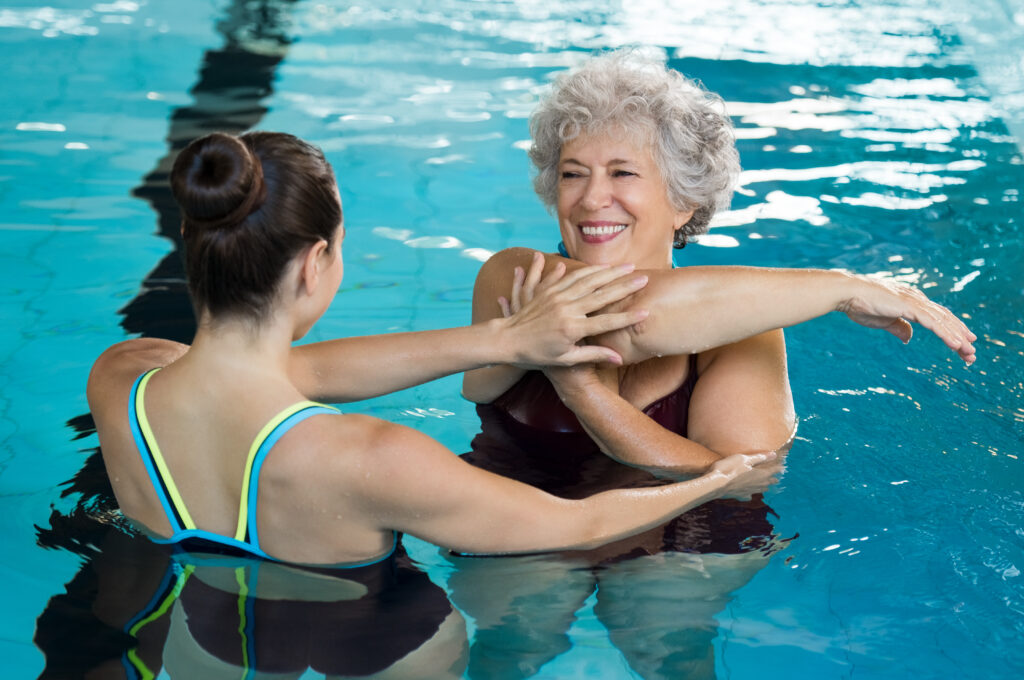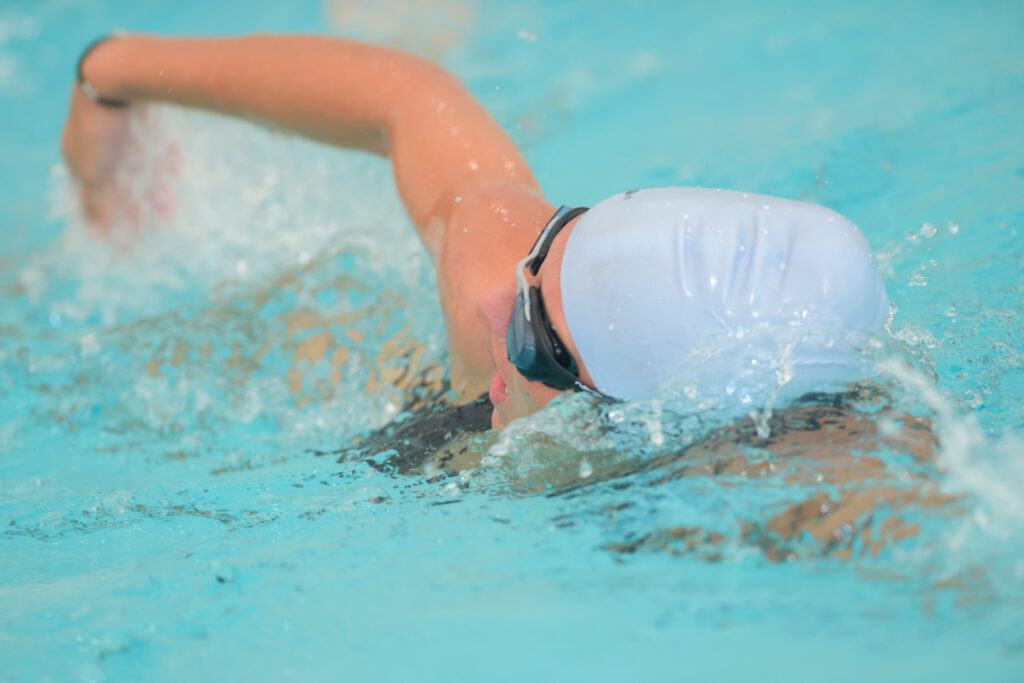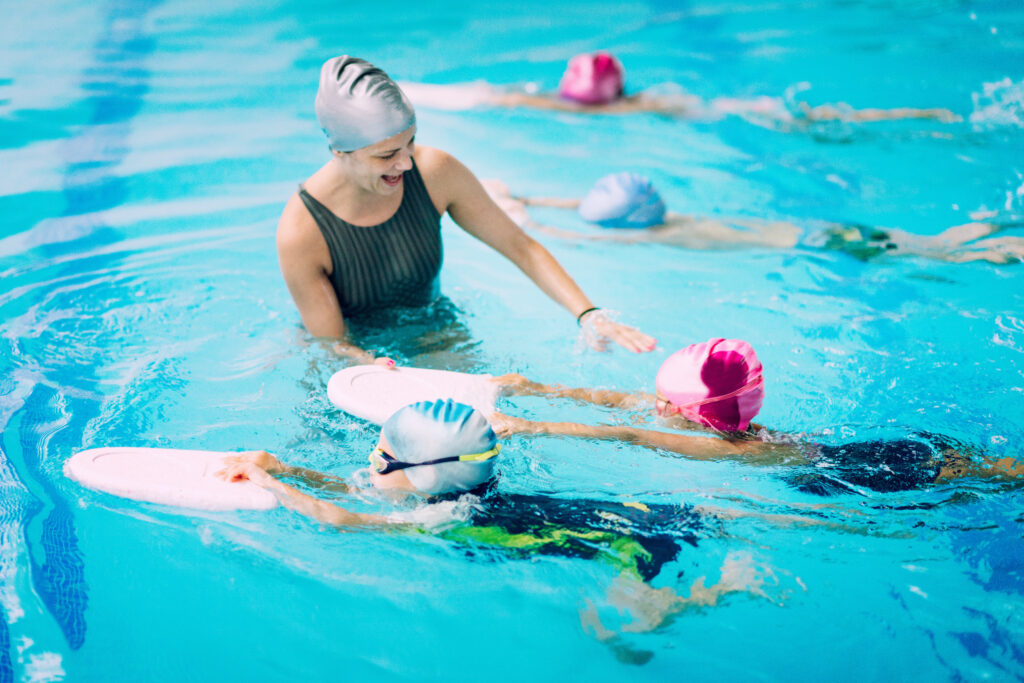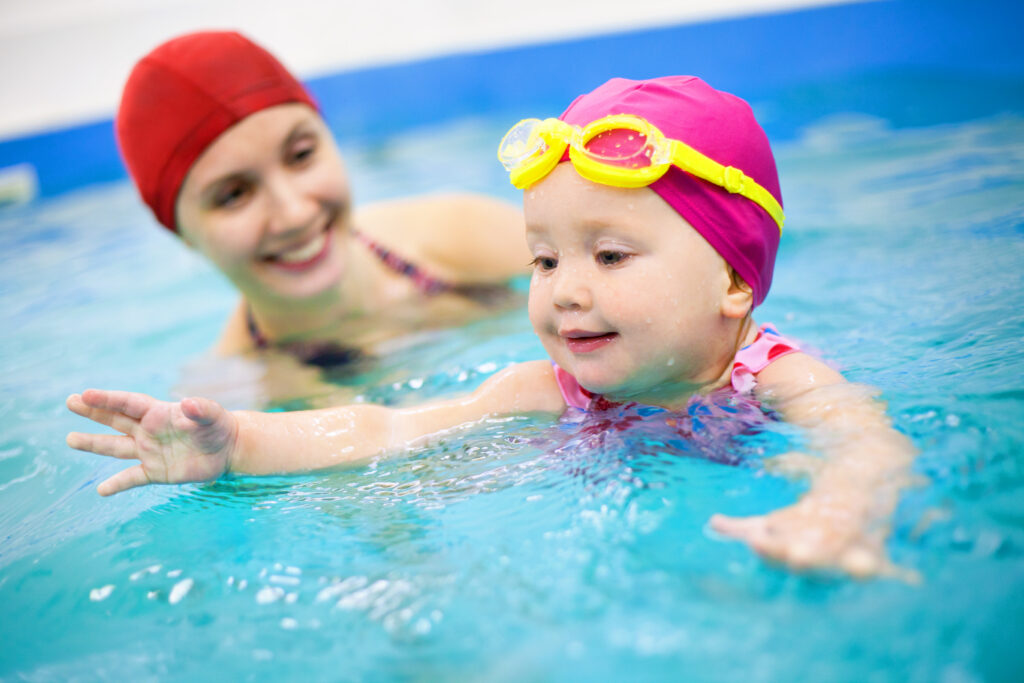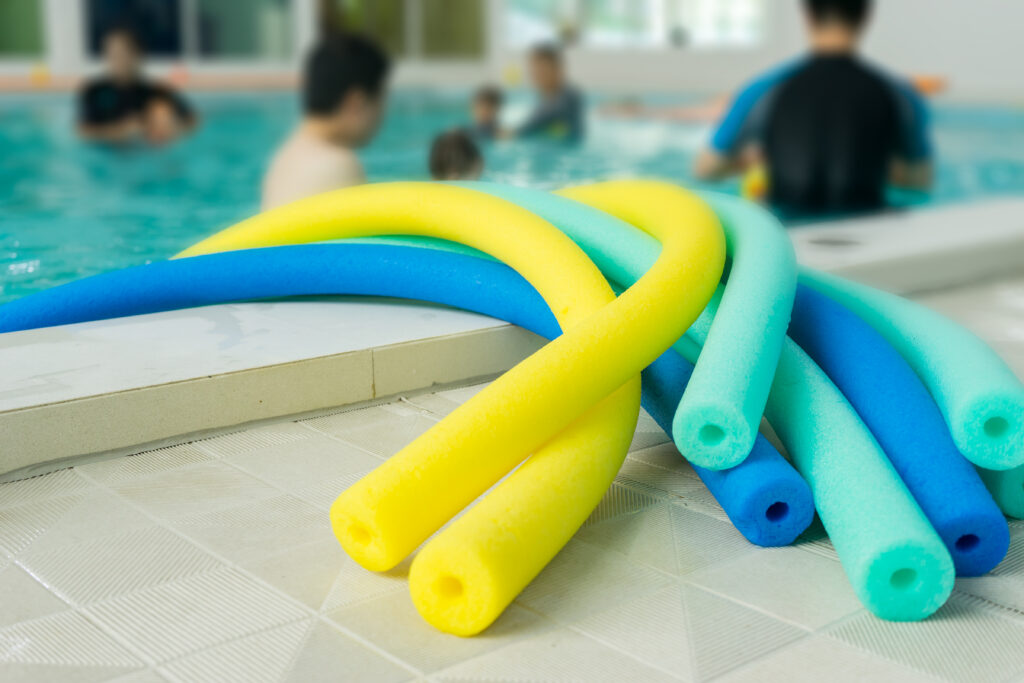When considering different forms of exercise for individuals with health conditions, such as arthritis, swimming emerges as a particularly beneficial activity. Its low-impact nature means that it places minimal stress on the joints, making it an excellent option for maintaining physical fitness without exacerbating pain or joint stiffness. As the water supports part of one’s body weight, this also aids in reducing the impact compared to weight-bearing exercises performed on land.
Swimming and water-based exercise promote cardiovascular fitness while also helping to maintain and build muscular strength. For individuals with arthritis, these aquatic activities not only improve circulation but also enhance joint flexibility. Health experts have long recommended swimming as part of a comprehensive arthritis management plan due to its ability to offer a full-body workout without risking further joint damage.
Benefits of Swimming for Arthritis

Swimming offers several advantages for individuals dealing with arthritis, including improved joint mobility, reduced stiffness, and increased muscle strength.
Improves Joint Mobility
Swimming makes the joints go through a full range of motion, thus enhancing joint flexibility. This can be particularly beneficial for arthritis sufferers, as maintaining and building strength and cardiovascular fitness is important in managing their condition.
Reduces Stiffness and Inflammation
The act of swimming stimulates blood circulation, which can help to reduce muscle stiffness and ease pain. The water’s warmth and buoyancy also contribute to a decrease in joint inflammation, providing relief to swollen and painful areas.
Increases Muscle Strength
Regular aquatic exercise like swimming can result in improved muscle strength. Supporting muscles around the joints become stronger, offering more joint support, which can be crucial for those with arthritis. Healthline notes that the combination of cardio and strength training in swimming helps not just with alleviating arthritis symptoms but also in preventing further joint issues.
Considerations Before Starting to Swim

Before taking to the water, individuals with health conditions such as arthritis should give careful thought to preparatory steps ensuring a safe and beneficial swimming experience.
Consulting With Healthcare Professionals
It is essential for individuals to consult their GP or a healthcare provider prior to starting a swimming routine, especially if they have arthritis or other health conditions. A healthcare professional can offer advice tailored to their specific medical needs, including the intensity and duration of swimming activities that are safe and therapeutic, as well as any necessary precautions that should be taken.
Choosing the Right Swimming Environment
Selecting an appropriate swimming setting is critical. People with health conditions should look for a pool with warm water to help soothe joint stiffness and pain, which is often associated with arthritis. They should also consider the pool’s accessibility, including features such as steps with handrails or a sloped entry that allows for easy and safe entry into and exit from the pool. Moreover, a swimming venue with lifeguards on duty and sessions specifically for those with health conditions can provide an extra layer of safety and support.
Types of Swimming Strokes for Arthritis
Choosing the right swimming stroke is essential for individuals with arthritis to maximise benefits while minimising joint strain. The following strokes are typically recommended for their gentle movements and therapeutic effects.
Front Crawl
The front crawl, or freestyle, is a smooth and efficient stroke characterised by alternate arm movements. These movements can help increase shoulder flexibility and strength without placing undue stress on the joints. Additionally, the consistent kicking motion encourages blood circulation, which is beneficial for those with arthritis.
Breaststroke
The breaststroke is highly recommended due to its gentle, gliding motions. It allows swimmers to keep their head above water, which can be comforting for beginners. Importantly, the breaststroke’s leg kick – a simultaneous outward and backward motion – can improve hip flexibility and has minimal impact on the knees.
Backstroke
Swimming the backstroke involves alternately sweeping one’s arms in a circular motion while lying on the back. It can greatly reduce the risk of joint stress since there’s no need to turn the head for breathing. The gentle rotation of the arms in the backstroke can strengthen the back muscles and enhance spinal support.
Swimming Techniques and Strategies
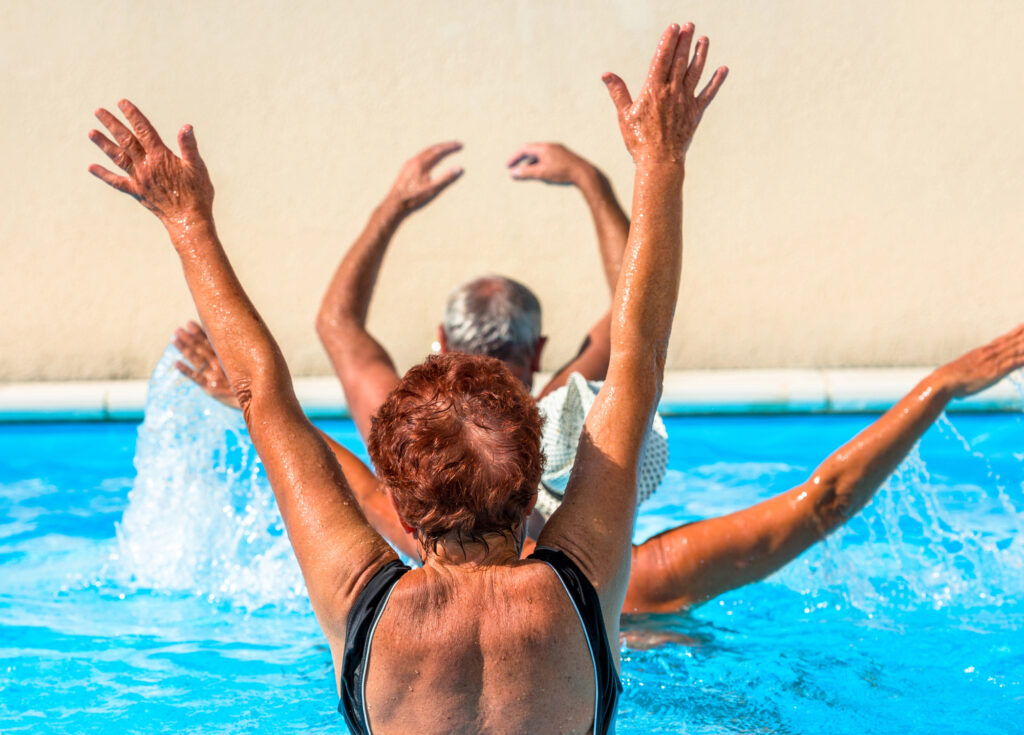
When integrating swimming into a routine for individuals with health conditions such as arthritis, it’s crucial to consider warm-up, stretching, and pace to ensure safety and effectiveness.
Warm-Up and Cool-Down Routines
A proper warm-up is essential before starting the swim session. This might include light aerobic movements on land, such as walking or gentle mobility exercises for about 5 to 10 minutes. These activities gradually increase heart rate and circulation, preparing the body for exercise. After swimming, a cool-down helps to slowly reduce heart rate and should include similar light activities, ensuring a smooth transition for the body back to its resting state.
Stretching Exercises
Stretching before and after swimming aids in flexibility and can help prevent injuries. Individuals should focus on stretches that target major muscle groups that will be engaged during swimming. For example, shoulder rolls and gentle arm stretches are beneficial, as they involve muscles and joints commonly used in swimming strokes. Stretching should be gentle and controlled, without causing pain, especially for individuals with arthritis.
Pace and Duration
Managing pace and duration is important to avoid overexertion, particularly for those with health conditions. Beginners or those with arthritis may start with shorter sessions, such as 10 to 15 minutes, gradually increasing as comfort and stamina improve. Swimming at a steady, comfortable pace helps maintain energy levels and reduces the risk of strain. Utilising intervals of swimming followed by periods of rest can also be an effective strategy to build endurance without causing unnecessary stress on the joints.
Adaptive Swimming Aids and Equipment

For individuals with health conditions such as arthritis, specialised swimming aids and equipment can maximise the benefits of aquatic exercise while minimising joint strain and discomfort.
Swim Paddles and Fins
Swim paddles and fins are designed to enhance stroke technique and improve muscle strength. Swim paddles target the upper body, increasing resistance during arm pulls to strengthen muscles while being gentle on the joints. Swim fins aid in lower body workouts, helping in leg strength development and cardiovascular endurance.
Buoyancy Aids
Buoyancy aids, such as swim belts and noodles, provide additional support in the water. These aids assist with maintaining proper body alignment and stability, allowing swimmers to focus on their movements without the added stress on their joints. The buoyancy of water significantly reduces the impact on joints, which is particularly beneficial for those with arthritis.
Therapeutic Exercise Tools
Therapeutic exercise tools such as aqua dumbbells and resistance bands are integral for water-based workouts. They are used to perform a range of exercises that improve flexibility, balance, and strength. These tools provide light resistance and aid in rebuilding muscle around arthritic joints, which is key for joint support and pain reduction.
Safe Swimming Practices for Individuals With Health Conditions
Swimming is a beneficial form of exercise for individuals with health conditions such as arthritis, due to its low-impact nature and the buoyancy of water reducing strain on joints. However, it is crucial to practise safe swimming techniques to prevent exacerbating any existing conditions.
Avoiding Overexertion
One should be mindful of not pushing themselves too hard during aquatic activities. It is advisable to start slowly, gradually increasing the duration and intensity of swimming sessions. This approach helps prevent stress on the body and minimises the risk of injury.
Recognising Signs of Discomfort
Individuals must listen to their bodies and be attentive to any signs of pain or discomfort while swimming. Should these symptoms arise, they are advised to stop immediately and consult a healthcare professional. Understanding one’s limits plays a vital role in maintaining safety during exercise.
Maintaining Regular Rest Intervals
Incorporating frequent rest periods into swimming routines can help individuals with health conditions manage fatigue. Structured rest intervals allow for recovery and help ensure that one doesn’t overtax their body, which can lead to increased inflammation or pain, particularly in those with joint-related conditions.
Lifestyle and Nutrition Tips for Swimmers With Arthritis

Swimmers with arthritis can benefit greatly from a tailored lifestyle and nutrition plan. Key areas of focus include a diet that supports joint health, proper hydration, and a strategic approach to rest and recovery.
Balanced Diet for Joint Health
For joint health, one’s diet should be rich in anti-inflammatory foods such as oily fish, which provide omega-3 fatty acids, and a variety of fruits and vegetables that offer antioxidants. Foods high in calcium and vitamin D, like fortified cereals and dairy products, are also essential for bone strength. Including foods with vitamin C and selenium can support the health of cartilage and reduce the severity of arthritis symptoms.
- Omega-3 sources: Salmon, mackerel, flaxseeds
- Calcium-rich foods: Milk, yoghurt, broccoli
- Vitamin C sources: Oranges, strawberries, bell peppers
- Selenium-rich foods: Brazil nuts, tuna, eggs
Hydration Strategies
Maintaining hydration is crucial for swimmers, as it impacts joint lubrication and muscle function. Drinking water consistently throughout the day is advised, and the inclusion of electrolyte-rich drinks can be beneficial during longer swimming sessions to replenish salts lost through sweat.
- Before swimming: Have 500ml of water approximately 2 hours prior
- During swimming: Sip small amounts regularly if swimming for over an hour
- After swimming: Rehydrate depending on the intensity and duration of the workout
Rest and Recovery
Proper rest and recovery are vital for managing arthritis symptoms. This includes adequate sleep, low-impact cross-training activities, and passive recovery methods. Swimmers should listen to their bodies and rest at the first sign of joint pain or excessive fatigue.
- Sleep: Aim for 7-9 hours per night for optimal recovery
- Low-impact activities: Consider yoga or cycling on non-swimming days
- Passive recovery: Use techniques such as stretching, foam rolling or warm baths to alleviate muscle tightness and joint stiffness
Frequently Asked Questions

Swimming is a low-impact exercise often recommended for individuals with arthritis to help manage pain and improve joint function. The following commonly asked questions address the specifics of swimming as exercise for those with arthritic conditions.
Can swimming alleviate symptoms of osteoarthritis in the knees?
Swimming can stimulate blood circulation and may reduce muscle stiffness, easing pain in the knees affected by osteoarthritis. The buoyancy of water lessens impact on joints, potentially providing relief.
What are the most beneficial swimming strokes for managing hip arthritis?
Freestyle and backstroke are swimming strokes that allow smooth movements without placing excessive stress on the hip joints. These strokes can help maintain flexibility and build strength in the surrounding muscles of the hips.
Why might joint pain occur after participating in swimming activities?
Joint pain after swimming may result from overexertion or improper stroke techniques, leading to muscle fatigue and strain. It is crucial to ensure that the exercise intensity is appropriate and that proper form is maintained to avoid post-swimming joint pain.
How does swimming in cold water impact individuals with rheumatoid arthritis?
Cold water can sometimes increase joint stiffness and discomfort for people with rheumatoid arthritis. Conversely, warm water swimming can soothe sore joints and ease achy muscles, suggesting that temperature plays a significant role in water exercise for rheumatoid arthritis.
What types of exercises are unsuitable for those suffering from arthritis?
High-impact exercises such as running, jumping, or weightlifting with heavy weights can aggravate arthritis symptoms due to the increased pressure they place on the joints. Individuals with arthritis should typically avoid these activities in favour of low-impact alternatives.
What is considered the optimum form of exercise for improving joint health?
Aquatic exercises, including swimming, are considered some of the optimum forms of exercise for improving joint health. Such activities can reduce pain, improve cardiovascular fitness, and enhance joint flexibility without excessive impact.

